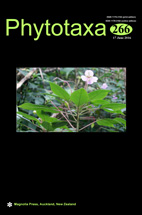Abstract
Rubus Linnaeus (1753: 492) is one of the largest genera in the family Rosaceae, represented by more than 700 species (Lu & Boufford 2003) and numerous apomictic taxa distributed worldwide but mainly in temperate regions (Mabberly 2008). The greatest species diversity of the genus is found in Southeastern Asia, East Asia and South America (Kalkman 1993, Gupta & Dash 2015a). The genus is recognized as one of the unsolved complexes for species delimitation due to hybridization, polyploidy and the large number of apomictic taxa (Weber 1996). The genus is characterized by woody or rarely herbaceous habit with simple to pinnate or compound leaves, terminal solitary to racemose and cymose inflorescence subtended by a foliar bract, pentamerous (rarely more petals) flowers with numerous stamens and pistils; drupaceous fruits with a distinct torus. A current estimate shows that, in India, about 75 species occur (Gupta & Dash 2015b) with the largest concentration in eastern Himalayan states. Hooker (1878) reported 41 species of Rubus from the then British India out of which 39 species and 15 varieties are found within the present political boundary of India. Long (1987) reported 35 species and 1 variety from Sikkim while dealing with Flora of Bhutan. Very limited information is available on the genus in India except some sketchy enumerations in the state floras (Kanjilal et al. 1922, Sharma & Kachroo 1981, Chowdhery & Wadhwa 1984, Chowdhery et al. 1996). Therefore, taxonomic treatment of less known Indian species of Rubus has not been worked out; as a result these names are only being referred as unresolved names in contemporary databases (e.g. The Plant List 2013).The majority were collected during the colonial era but without any designation of types. Therefore, to maintain the current taxonomic status, detailed studies are needed for all these species. We (first two authors) currently are revising the taxonomy of Rubus in India and this is part of the PhD thesis of the first author. During our research, we traced specimens of Rubus collected from western Himalaya (India) referable to less known and untypified R. chambicus Rolfe (1920: 132) and R. almorensis Dunn (1921: 310).

